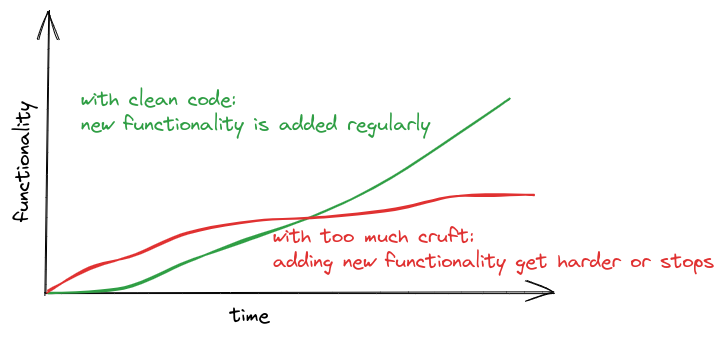Most software projects end up in a big ball of mud. The major cause is neglecting internal quality and focusing on adding features with dirty hacks because of unrealistic timelines. Code has the natural tendency to erode if you don’t launch countermeasures permanently. This observation applies to all systems and is also known as the the second law of thermodynamics:
Systems tend to arrive at a state […] where the entropy is highest […]
The only way to prevent a big ball of mud is to ingrain continuous refactoring into the software creation process, i.e. continuously writing clean code. Refactoring must be a regular task whereby it can happen before or after implementing a new feature itself:
Make it work, make it right, make it fast. - Kent Beck (refactor afterwards)
Make the change easy (this can be hard), then make the easy change. - Kent Beck (refactor beforehand)
Often teams code for months or years without touching and restructuring the existing codebase. They perpetually add features with dirty workarounds and without thinking about the overall structure. This accumulates and adding new functionality will become harder, and eventually impossible [1]

It is always better to stick to clean code and avoid shortcuts. Investing in internal quality is cheaper than adding cruft. Cruft makes the system harder to modify and is introduced due to laziness, time pressure or simply lack of knowledge. Beware of programmers who did not internalize clean code. In order to make the deadline, they integrate dirty hacks, workarounds or skip tests. They justify their actions with flimsy arguments. Worse yet, because the management is not aware of internal quality, the milestone is perceived as a success and dirty developers are sometimes celebrated as heros. In consequence of such bad incentives, the codebase will deteriorate quickly since dirty developers gain the upper hand and quality-focused developers are ignored (and leave the company). The epitome of such bad developers are tactical tornados – loved by the management, hated by fellow team members.
The big problem with cruft is that it comes silently and sneaks into the codebase over time. There will be no single decision which turns a codebase into a big ball of mud all of a sudden. Instead daily tiny decisions bring the system slowly into an unmaintainable state and the problem will only be detected when it is too late and the pain is severe. More often than not, the only rescue is a complete rewrite of the application.
One of the biggest mistakes developers can make is skipping tests due to time pressure. If a developer team made the milestone, everybody is happy and the team is rewarded. This leads to a positive feedback loop which exacerbates the situation: the developers will regularly skip tests or generally write bad code since they get rewarded by the clueless management. Bad developers bring up the idea to skip tests themselves because they believe they are faster without tests. This is a fallacy! As soon other developers need to make a change, they will be slowed down immensely and bugs are introduced easily. Even the original authors will struggle with their own code without tests when they have not looked into it for some time. A good test suite act as a safety net and gives guidance how to use the API. All developers benefit from it, introduce less bugs and are faster.
The only way to go fast, is to go well. - Uncle Bob
Attention!!!
Is refactoring always the right way? It depends. Some developers tend to overdo things like over-engineering, gold-plating and over-refactoring. Be vigilant, don’t fall into the trap doing weeks or months of refactoring without new features. This is not refactoring but most probably a rewrite of an application. Refactoring and adding new functionality should be in balance. Finding a balance is a discussion between tactical vs strategic programming. Investing 10-20% of time into code improvements is a good starting point.
Final Thoughts
Practicing the Continuous Clean Code Process (CCCP) is critical to prevent a big ball of mud. Through continuous refactorings, not only codebases stay clean, they are fun and as a side-effect teams end up with a maintainable codebase which is a pleasure to work with. Developer happiness will be high. A clean codebase builds the foundation for fast development over time and high-quality products. Organizations will also profit since happy developers are more productive and attract even more good developers. Finally there is no excuse to write bad code 😄 – but it is still hard.
Star Wars Fun Facts
CCCP is also known as C3-PO.